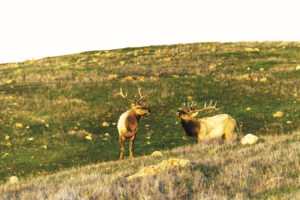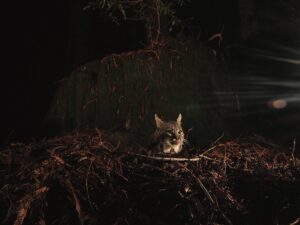It lies at the heart of one of the country’s most densely populated regions like a great, if somewhat tarnished, sapphire: San Francisco Bay. For more than a hundred years it has endured siltation, dredging, draining, diking and pollution. More than 90 percent of this estuary’s rich marshlands have been lost, and water quality, fisheries, and wildlife have all suffered dire declines. But finally, the Bay stands poised to reclaim its ecological heritage; it is now the centerpiece of one of the most ambitious environmental restoration programs in the country. A coalition of government agencies, local communities, and environmentalists are marshaling their resources to turn 16,500 acres of salt evaporation ponds ringing the South and North Bay, until recently owned by the Cargill Corporation, back into wildlife habitat.
When the project is completed—which may take decades and cost millions—it is likely the Bay will more closely resemble its original state than it has at any time in the past century. Thousands of acres of new tidal marsh will grace the shoreline, nurturing juvenile fish and shellfish, filtering pollutants from creeks and urban runoff, and sheltering endangered birds and mammals.
“There is really nothing in the country comparable to this project,” says Denise Reed, a professor of geology and geophysics at the University of New Orleans who serves on numerous scientific advisory panels on wetland rehabilitation for the Atlantic, Gulf, and Pacific Coasts, including one for the Bay’s salt pond project.
It’s not just that this particular estuarine project is so large, says Reed. A 16,000 acre restoration would be huge for any region, she notes, “but we also have to consider the urban context. This won’t simply restore critical ecological components—it will also give a great number of people a direct relationship with the process.” No other large urban area has a resource equivalent to the salt ponds, says Reed.
“In New York, Jamaica Bay is the only significant project under way,” Reed says, “but it’s tremendously degraded, and only consists of a few hundred acres. Seattle lost huge amounts of wetlands around Puget Sound, but today only patchwork restorations are possible. Yet here, in San Francisco Bay, we can work with an entire landscape. It’s really quite thrilling.”
It is the essential nature of south San Francisco Bay’s salt ponds that make it possible to even contemplate such a grandiose effort. This vast complex of evaporators—created by dredging and filling swaths of the Bay’s salt marsh, seasonal wetlands, creek corridors, and uplands—has been used for salt production for more than a century. The Cargill Corporation acquired them from Leslie Salt in 1978. In 2003, state and federal agencies—with assistance from several local private foundations—purchased 1,400 acres of these ponds in the North Bay and 15,100 acres in the South Bay for $100 million. The goal now is to transform the ponds into a landscape that incorporates diverse wetland types and habitats of concern, including ample salt marsh, of course.
The dream of restoring a significant portion of the Bay’s tidal marsh was first articulated in 1993 by the Baylands Ecosystem Habitat Goals Project, an ad hoc group of scientists, resource managers, and environmentalists. In 1998, the group presented its formal recommendations, including, among other things, the restoration of between 95,000 and 103,000 acres of tidal marsh (originally, the Bay supported 187,000). Ideally, the team opined, the new tidal wetlands would take the configuration of large chunks of marsh (2,000 acres or more), connected by corridors sufficiently large to allow the easy passage of wildlife.
Now it’s showtime, and the stage—the South Bay salt pond complex—is being readied for the first performance. No one quite knows what will happen when the curtain goes up, but the excitement levels for players and observers alike are high. With much hoopla, top regional managers opened the screw gates to the Alviso pond system this July in a first step toward long-term public stewardship, allowing the tides to go both in and out of this once closed system and the ponds to stop making salt.
Salt pond restoration has been addressed before in the Bay Area. In the North Bay, 10,000 acres of ponds acquired ten years ago continue to stutter toward the tides. Only a single pond, Pond 2A, has been restored to tidal marsh so far. On another pond, bureaucrats and environmentalists remain at odds over how to remove bittern—highly concentrated salt-production residues. As for the rest of the ponds, locals have signed off on tidal marsh restoration for 3,000 acres and infrastructure repair for another 1,700 acres, and construction should begin next year.
Salt pond restoration has a more established track record in the South Bay, and in particular at the Don Edwards National Wildlife Refuge. Founded in 1974 and administered by the U.S. Fish and Wildlife Service, Don Edwards was the country’s first urban national wildlife refuge. This 30,000-acre preserve, cheek-by-jowl with the ponds currently targeted for restoration, has grown by bits and pieces over the years; most of the land, not surprisingly, was obtained from Cargill.
While Cargill has maintained salt production rights on many of these ponds, the refuge has restored a few to tidal marsh, a boon to the California clapper rail and the salt marsh harvest mouse, both listed species that have suffered precipitous declines due to tidal wetland destruction. Most notable among the restored tracts is LaRiviere Marsh, a 100-acre demonstration project near the refuge’s visitor center. The site was graded to a more natural topography and the levees breached. From that point, the Bay was left to do most of the work.
Managers discovered a great deal about restoration from LaRiviere, says refuge chief Clyde Morris. And yet, much remains to be learned. And the first years of the surrounding salt pond restoration effort, he intimates, will be a groping toward enlightenment.
“This isn’t going to be a matter of devising a full-blown strategy and then executing it all at once,” Morris says. “For the first few years, everything will be strictly pilot projects. We’re going to be monitoring the hell out of them, and applying the lessons we learn on an ongoing basis. Will it be challenging, even difficult? Yes. Can it be done? Yes.”
Morris notes that Don Edwards Refuge must respond to a number of different imperatives and he is convinced the South Bay salt pond restoration effort will have to dance to the same multiuse tune. Given the way things are shaking out, he estimates the final configuration of the South Bay project will run to about two-thirds restored marsh to one-third managed ponds, with a wide range of sub-habitats incorporated in the edge zones.
“We need the salt marshes, not only for our listed species, but also for their function as fish nurseries and pollutant filters,” he says. “On the other hand, ponds managed for wildlife—not salt—are essential to our shorebirds.”
Shorebirds, in fact, constitute the main argument for resisting the temptation to convert all the ponds into tidal marsh. Research by ornithologists, including Sarah Warnock, a biologist for the Point Reyes Bird Observatory, indicates the ponds are not merely convenient habitat for shorebirds; they are absolutely essential.
The ponds, says Warnock, provide critical foraging habitat and shelter for at least 20 species, but western sandpipers are particu-larly dependent on them. In spring, she observes, their numbers on the ponds can swell to 700,000, a significant percentage of the population on the Pacific Flyway, a critical migratory route. One of the compelling reasons to study western sandpipers is that they’re a keystone species, says Warnock; their numbers say a lot about shorebirds and their habitats in general.
The ponds are of particular importance to shorebirds in the winter. During big storms, Warnock says, the birds are driven off their foraging grounds in more exposed locales. Back before the West Coast’s tidal areas were subjected to dredging, siltation, development, and other indignities, there were sufficient expanses of flats situated leeward of wind and weather to protect the bulk of the sandpiper population. Now, in California at least, the salt ponds are about all that’s left of this unique “storm shelter” habitat.
Birds, wildlife, and fisheries stand to be the big beneficiaries of the restoration, of course, but there are other constituencies with stakes in the Baylands. And if the project is to succeed, say its supporters, their concerns must be addressed. Recreation is a case in point.
“These restored lands will be an oasis in an urban landscape, a tremendous source of solace for many people,” says Morris. “So providing access is extremely important: We have to determine appropriate uses, and make sure the opportunities to pursue them exist, whether it’s bird-watching, bicycling, fishing, or duck hunting.”
Flood control is also a hot-button issue for the South Bay wetland project. In the past, the ponds have provided low-lying communities like Alviso protection from inundation. “If you completely eradicate the flood control component, you have a no-starter for restoration,” Morris observes. “You simply don’t want to contribute to flooding in Alviso—that’s a basic reality.” But if some of the ponds are configured with flood control and marshes in mind, he says, they can be managed as both wildlife habitat and de facto bypasses, where flood waters and exceptionally high tides can sheet out rather than swamping houses, offices, and communities.
There are other challenges to meet in restoring these ponds, among them exotic species. The Bay is hardly a pristine system. Hitchhiking opportunists from around the globe have displaced indigenous species. Oyster drills, Manila clams, and Asian clams have supplanted native mollusks. Mitten and green crabs are competing with hometown Dungeness and red rock crabs. In any restoration scenario, exotics constitute a potential wet blanket.
Among Morris’s most significant concerns is the eastern red fox, a canid that is far more disposed than the smaller native gray fox to forage in wetland areas. When the red foxes come in, the rails disappear, he observes. More problematic than the fox, even, is Atlantic cordgrass—Spartina alterniflora—and its numerous hybrid forms. It differs from the native West Coast cordgrass, Spartina foliosa, in its exuberance. Western cordgrass more or less stays put, but Atlantic cordgrass is almost metastatic in its growth. Planted in San Francisco Bay in the mid-1970s as part of an early restoration project, it has the potential to turn the entire intertidal zone into an unruly and biologically impoverished greensward.
“It grows so densely that it chokes off the little dendritic sloughs that characterize our native cordgrass and pickleweed marshes,” says Marc Holmes, the Bay restoration program director for The Bay Institute, based in Marin. “Clapper rails, particularly, need that slough environment; it’s their primary habitat.”
Once Atlantic cordgrass gets established, warns Holmes, aggressive—indeed, virtual scorched earth—tactics are required to remove it. “We’re talking about significant spraying and excavation,” he says. “Half measures won’t work.” On the plus side, project planners are taking the spartina threat seriously indeed. A special program, the Invasive Spartina Project, has been funded to deal with it.
Morris emphasizes that any control program must be considered open-ended: “Controlling exotics will be an ongoing process. Once they get into a system, it’s unlikely you’ll ever wipe them out completely.”
Then there is the problem of mercury methylation. South Bay sediments are distressingly rich in mercury, in large part the result of a now-decommissioned cinnabar mine on the upper reaches of the Guadalupe River. Research has demonstrated that wetlands can augment the “methylation” of mercury. That’s because bacteria convert elemental mercury, which is generally inert, into methylmercury, a form that insinuates itself into living tissue with potentially catastrophic results. Microbe populations typically are higher in wetlands than open water, causing some concern that the restoration might increase the release of bioavailable mercury into the environment.
Lynne Trulio, the lead scientist for the restoration project and the chairwoman of the environmental studies department at San Jose State University, says more research needs to be done on the methylation process and then integrated into the restoration plan. But she doesn’t expect mercury concerns to utterly derail wetland restoration around the Bay, a possibility that has occasionally been bruited about in the press.
“Personally, I want to see an overall improvement in ecological functioning in the South Bay, and I think we’re heading in that direction,” Trulio says. “We know we don’t know enough about the restoration process; that’s why the first phase essentially will consist of pilot projects, intensive monitoring, and collecting data.”
A key element to restoring marshlands is sediment. Many of the ponds have subsided deeply through their years of salt production, some up to 10 feet below natural marsh elevations. Turning those impoundments from lakes to marshes will require vast amounts of clean fill. Why? In the simplest terms, mud and silt are needed to fill some ponds, to bring their bottoms closer to natural marsh levels. Otherwise, they’ll simply stay deep bodies of water; plants won’t grow and the ponds will never become marshes. And it’s not clear if there’s enough mud to go around. Millions of cubic yards of the stuff are needed.
“There have been conflicting predictions of the amount of sediment available to the system from both natural and artificial sources,” observes Michelle Orr, an engineer for the San Francisco hydrology firm of Philip Williams and Associates. Orr is charged with figuring out the best way to move water and sediments through the project area. She must figure out where to breach levees so restoration goals are achieved in the most efficient way possible.
Some sediment will be available for artificially raising the levels of some of the shallower ponds, Orr says, but importing large quantities of sediment is prohibitively expensive. Most of the sediment for the project will have to come in on the tides through levee breaches, and researchers are now calculating just how much sediment they may get from this natural source. But even then, there is not enough to realize a complete tidal marsh restoration scenario. The ponds that are lowest are unlikely to become tidal marshes. Deep ponds they are, and deep ponds they’ll probably stay—inappropriate habitat for clapper rails or western sandpipers, but diving ducks like canvasback, redhead, and greater scaup will be pleased.
Orr is working on a restoration scheme that will encourage the mud to migrate where it’s needed. “The restored ponds will become a new tidal sink for sediment,” she says, “but it won’t happen overnight. Time is an extremely important element in this process. For some of the subtidal areas, it will take years, decades even, to transform them from shallows and mudflats into vegetated tidal marsh. But that isn’t necessarily a bad thing. As the restoration proceeds, we’ll be providing a succession of niche habitats that different species will be able to exploit.”
One pilot project that should demonstrate this successional process is Eden Landing, also known as the Baumberg tract, an 832-acre property acquired from Cargill by the California Department of Fish and Game in 1995. Biologists began working on restoration plans immediately after acquisition, says Carl Wilcox, the agency’s habitat conservation manager for the Central Coast region. The site, Wilcox observes, is ideal for an initial project: While challenges exist (for one, the epicenter of the exotic spartina invasion lies next door), they aren’t overwhelming, and the payoff should be considerable. “Most of the ponds aren’t terribly subsided, so we aren’t too worried about sediment availability,” Wilcox says. “We’re going to monitor the whole project closely, compiling data on biological responses that can be used in the larger restoration process.”
Research and experimentation are nothing if the results aren’t put to good use by the public powers that be. Diplomacy has been described as the art of the possible. Increasingly, it seems the same may be said of ecological restorations. People who become involved in such projects tend to have high ideals, and that’s a good thing. But sometimes—no, make that most times—those ideals may be pulling in tangential directions. A good restoration is the axiomatic win-win situation: Everybody gets something. At the same time, it has to be remembered that when everybody gets something, nobody gets everything. Still, in this particular project, many of the stakeholders are getting more than they ever thought possible. Achieving that reality has been quite a dance.
“It’s all a matter of trying to balance opportunities and constraints,” observes Steve Ritchie. As the California Coastal Conservancy’s executive project manager for the South Bay salt pond restoration, Ritchie oversees the entire project.
“In order for this to happen at all, we have to actively engage the public,” he says. “We have to solicit ideas and put them on maps. People with different points of view have different anxieties. We have to address them all.” Generally speaking, says Ritchie, “The dialogue has been civilized. We’re continuing to take pains to make sure people understand they will be heard, that their viewpoints will be incorporated to as great a degree as possible.”
Within these constraints of basic public acceptability, he adds, it is essential that the restoration be driven by science, not narrow constituencies. Such an ambitious project, Ritchie emphasizes, amounts to a launch into the unknown. The target is clear: a healthier, cleaner, biologically richer Bay. But at this point, the trajectory parabola is uncertain. The only sure thing is that it will take a great deal of work, a ton of money, and a significant quantum of time to reach the destination.
“As we change the landscape, we have to track the results of our actions so we can replicate desired effects and avoid undesired ones in the later stages,” Ritchie says. “We’re all going to learn as we go. And that means we’ll all be learning for many, many years.”

.jpg)



